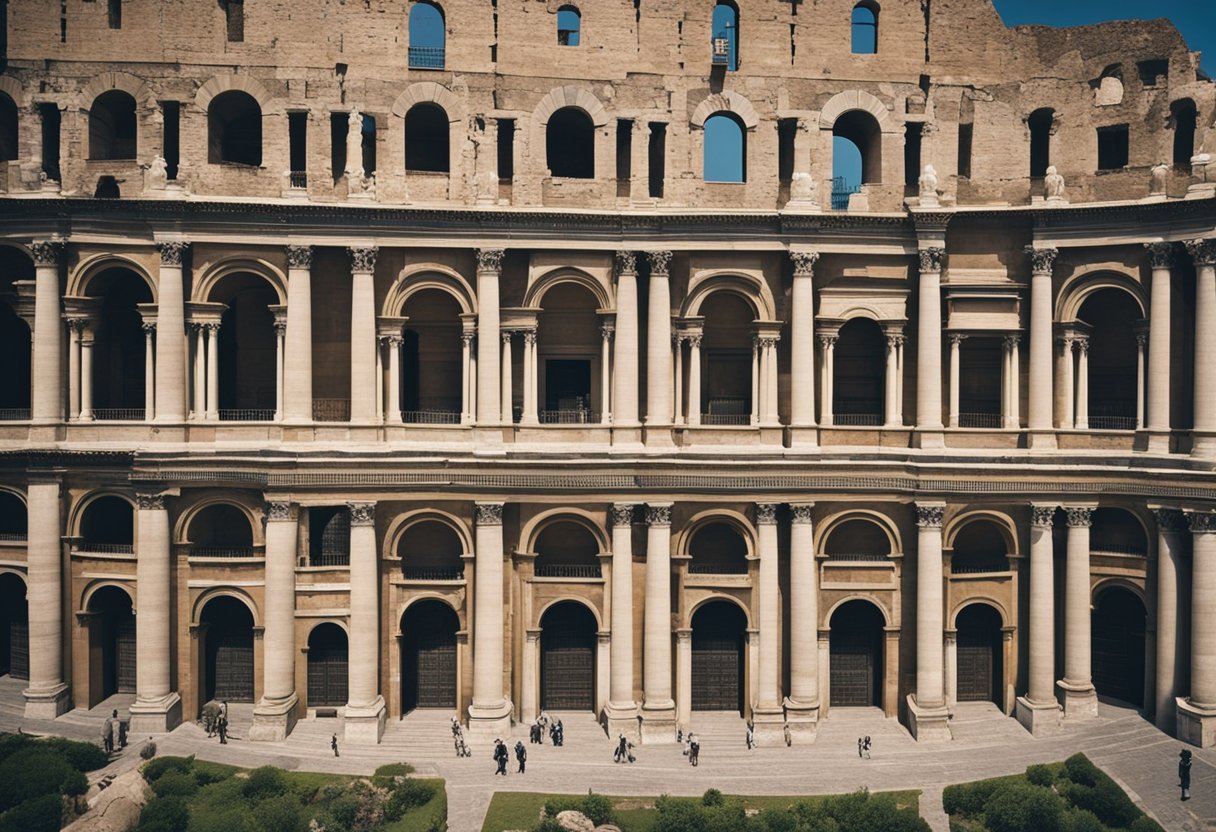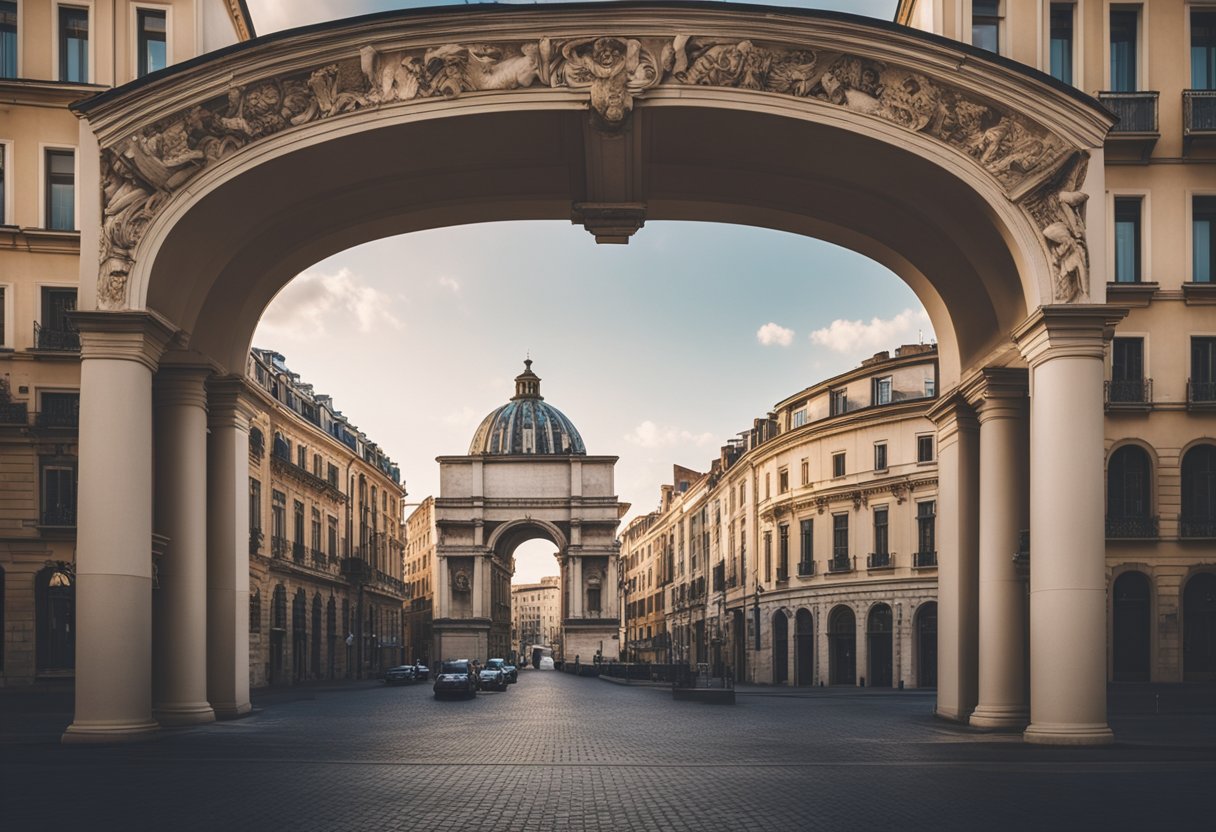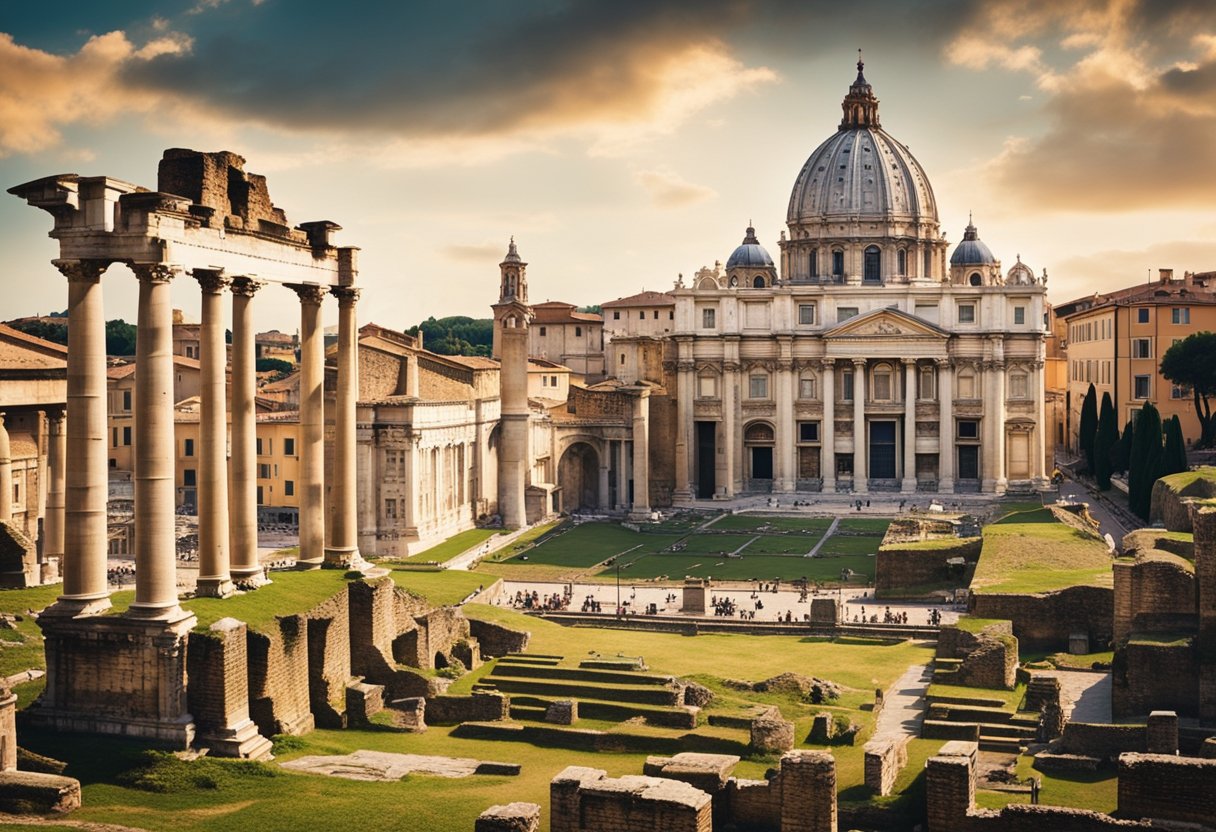The Roman Empire’s Legacy: Discover Captivating Cultural Influence in Europe

Updated On: April 22, 2024 by Fatma Mohamed
The Roman Empire’s extensive reach and profound influence have woven a complex tapestry throughout European culture that persists to this day. From the well-structured roads that crisscross the continent to the foundations of Western legal systems, Rome’s legacy is indelibly imprinted on the fabric of modern society. Throughout its long history, the Roman Empire not only dominated much of the known world but also implanted the seeds of cultural and technological innovation that would sprout and flourish long after its decline.

Our exploration of this legacy reveals the remarkable ways in which ancient Rome continues to shape our art, architecture, engineering, and governance. Architectural innovations such as the arch and the aqueduct have inspired countless structures around the globe. The Latin language, once the lingua franca of Rome, has given rise to the Romance languages and numerous English words. Even today, the Roman impact on law, administration, and urban planning remains a cornerstone of how we organise and govern our societies.
Table of Contents
Rise and Expansion of the Roman Empire
In this section, we explore the meteoric rise of Rome from a republic to a dominant empire and the series of military conquests that forged its expansive territory.
Roman Republic and the Ascension to Empire
Rome began as a Republic in 509 BCE, a system that combined elements of democracy, oligarchy, and monarchy. The political power was shared between the Senate—a body of leading citizens—and elected magistrates. Over time, the Republic laid the groundwork for an imperial trajectory marked by strategic governance and military strength. It was Julius Caesar’s rise to power and his subsequent assassination that primed the Republic for its transformation. Augustus Caesar, his adopted heir, later emerged as Rome’s first emperor in 27 BCE, heralding the era of the Roman Empire. Augustus’ reign brought about unprecedented internal peace and expanded the empire immensely.
Key Military Campaigns and Annexations
Military campaigns were central to Rome’s expansion. During the Republic, Rome’s military prowess was already well established, enabling the annexation of territories including Gaul, Spain, and Northern Africa. The empire’s legions, known for their exceptional discipline and organisation, pushed the boundaries of Rome even further. Under Augustus, the empire secured its hold over Italy and expanded its frontiers across Europe and beyond. Not only did these campaigns enable Rome to accumulate vast wealth and resources, but they also facilitated the spread of Roman culture and set the stage for a long-lasting legacy.
Roman Government and Political Structure
The intricate fabric of Roman government laid the foundation for modern governance, with a robust structure of the Senate, magistrates, and later, the imperial authority, each integral to the administration of the ever-expanding empire.
The Senate and Governance
The Roman Senate was a pivotal institution in the Roman Republic, responsible for advising magistrates and consuls. Composed of patricians—elite members of society—the Senate directed foreign policy, controlled finances, and handled administrative duties. Its influence was felt throughout the Republic and the initial years of the Empire.
Magistrates and Consuls
Magistrates served as the elected officials of the Republic, ranging from junior officers to senior positions. Among the highest offices were the consuls, elected annually to lead the Roman military and preside over the Senate and assemblies. Magistrates were vested with significant powers, both civil and military, crucial for the Republic’s governance.
The Transition from Republic to Imperial Rule
Rome’s shift from a Republic to Imperial rule was marked by civil unrest and the concentration of power among individuals like Julius Caesar. It culminated in a new era of monarchy under the title of Emperor, starting with Augustus. This seismic transition saw the Senate’s influence wane as the Roman Emperor assumed supreme authority, heralding the age of the Roman Empire.
Legal Contributions and Roman Law
As custodians of history, we recognise the vast impact of Roman law, which stands as a cornerstone of European legal tradition. It laid the groundwork for modern legal systems, infusing them with principles of justice that continue to guide our jurisprudence.
Development of the Roman Legal System
Roman law evolved over a millennium, its growth mirroring the expansion of the Roman Empire. Starting with the Law of the Twelve Tables in 450 BC, a foundational text that would inform future legal codes, the system grew to an intricate corpus of laws and edicts. Renowned figures such as Cicero contributed to its intellectual underpinnings, merging legal theory with philosophy and advocating for the role of natural law—an intrinsic, universal order of justice beyond the edicts of man.
The Roman legal framework rested on written statutes, jurisprudential analyses, and a complex hierarchy of courts. It distinguished between ‘ius civile’, applicable to Roman citizens, and ‘ius gentium’, for cases involving non-citizens. A series of treatises and legal findings, some penned by eminent jurists like Gaius and Justinian I, expanded this legal corpus further, encapsulating the breadth and depth of Roman legislative achievements.
Influence on Modern Legal Frameworks
Roman law’s influence persists today, especially in civil law jurisdictions across Europe. Many modern legal concepts, like contractual agreements, personal property rights, and torts, find their origins in Roman ordinances.
Our modern justice system owes a significant debt to Roman precedents. The Romans were pioneers in establishing the concept of legal personality, the idea that law transcends physical borders and societal status. These principles laid the groundwork for our current understanding of corporate entities and international law.
Italy and other former Roman territories have codified laws directly descended from Roman legal texts. The famed Corpus Juris Civilis, commissioned by Emperor Justinian in the 6th century A.D., not only consolidated Roman law but also became a reference that spurred the revival of Roman legal principles during the European Renaissance.
This legal inheritance supports the scaffolding of justice across Europe, ensuring that the concepts of fair representation and equality before the law remain at the heart of our legal discourse. Lawyers and legal scholars often look back to Roman law for its articulate expression and reasoning, with its historical treatises still used in legal education and interpretation.
Roman Engineering and Architectural Innovations
We observe the striking legacies of Roman engineering and architectural prowess that chart a course through Europe’s cultural landscape. The Roman Empire bequeathed innovations that were significant not just in their construction but also in the cultural connective tissue they provided across the continent.
Infrastructure and Urban Planning
The Romans excelled in creating infrastructure that shaped the urban landscapes, many of which persist to this day. Aqueducts were marvels of engineering, delivering fresh water to cities and enabling urban centres to thrive far from water sources. Roads and bridges were systematically constructed, enabling trade and military movements that knit the empire together. The Roman roads were built with precision and designed for durability and efficiency; a testament to this is that some are still in use. Bridges, too, stand as durable monuments to Roman engineering.
Invention of Concrete and Utilisation
The Romans’ invention and utilisation of concrete was a game-changer for architectural innovation. With this material, they constructed enduring structures often imitated but never surpassed in the ancient world. The development of the arch, the dome, and the vault—all made more robust by their use of concrete—meant they could build more significant, more ambitious and more enduring structures. The Colosseum stands as a prime example, showcasing not only their architectural skill but also Roman society’s values and priorities.
Concrete allowed Romans to create forms that were previously impossible, leading to an architectural revolution that influenced the development of buildings for centuries to come. The use of the arch, in particular, facilitated the construction of large open spaces and was crucial in bridge and aqueduct design. The dome, epitomised by the Pantheon, exemplified this technique’s apex, with its vast, open interior space that still impresses modern visitors.
Through these subsections, we have explored just a fraction of the rich tapestry of Roman engineering and architecture—a legacy that still resonates in the bones of Europe’s cultural heritage.
Cultural and Artistic Achievements

The Roman Empire left an indelible mark on the cultural canvas of Europe with its rich artistic legacy and its profound influence on literature and philosophy.
Art and Sculpture
Roman artists were adept at using various mediums, from amber to marble, embracing both indigenous styles and the influence of captured lands. Their prolific sculpture work still captivates audiences today, often characterised by realism and a tendency to capture the intricate details of human form. The Romans did not merely copy Greek sculptures; they also imbued them with their own innovation and style, creating vast collections of art that are still celebrated.
In the realm of art and sculpture, the Romans were known for their grandeur. They showcased a range of techniques in frescoes, mosaics, and statues, which often depicted gods, emperors, and other figures of significance with a level of naturalism that was unparalleled in the ancient world.
Literature and Philosophy
Ovid, Virgil, and Horace stand prominently as authors who influenced not just the Rome of their own times but also future generations across Europe. They brought a poetic dimension to Latin, enriching it and making it a worthy vessel for sophisticated expression. Their works reflected their worldviews and depicted the social and moral fabric of Roman society at the time.
The Roman Empire, particularly in the Greek-speaking Eastern territories, became a melting pot of cultures. This unique blend of Roman and Greek culture fostered a great exchange of philosophical thoughts and literary trends. Romans adapted Greek concepts to shape their own cultural identity, producing works of philosophy that questioned existence, governance, and human nature.
In this way, we see how the Roman Empire bridged the gap between different societies, creating a lasting cultural heritage that continued to influence Europe long after the fall of Rome.
Impact on Language and the Birth of Romance Languages
The Roman Empire’s linguistic legacy is profound, particularly in the genesis and development of the Romance languages that continue to influence the world today. This section explores the transformation from Latin, the linchpin of Rome’s linguistic domain, to the emergence of its linguistic progeny.
Evolution of Latin
Latin began as the language of a small urban community in Latium, the region which encompasses modern-day Rome. As Rome’s political power expanded, Latin spread across the Italian Peninsula, absorbing elements from other languages and evolving in response to the Empire’s growing complexity. This linguistic metamorphosis saw Classical Latin, the formal language of literature and administration, diverge from the spoken ‘Vulgar Latin’. It’s the latter form that laid the groundwork for the development of the Romance languages.
From Latin to Romance Languages
By the fall of the Roman Empire, regional varieties of Vulgar Latin had begun to differentiate significantly. Through centuries of evolution, five major Romance languages emerged: French, Spanish, Italian, Portuguese, and Romanian. While sharing a common root, each language carved its unique identity, heavily influenced by regional cultures and the historical interplay with other linguistic groups.
Spread of Religion and Philosophical Thought
We shall now explore the pivotal role the Roman Empire played in the dissemination of religious beliefs and the exchange of philosophical ideas across Europe.
Adoption and Spread of Christianity
Christianity, initially a marginal sect, found a fertile ground for growth within the Roman Empire. Despite initial persecution, it gradually became more accepted, culminating with Emperor Constantine’s conversion and the subsequent Edict of Milan in 313 AD, which granted tolerance to all religions within the empire. The Church became an integral institution, shaping European spiritual and cultural landscapes profoundly. Christianity’s spread was characterised by the establishment of bishoprics and the adoption of Latin as the liturgical language, amplifying its reach.
Roman Polytheism and its Transformation
Before Christianity, Roman religion was predominantly polytheistic, with a pantheon borrowed from the Greeks and adapted to Roman society. This belief system underwent a significant transformation as the empire expanded, absorbing deities and rituals from conquered lands. Philosophy, too, was a borrowed commodity, with the Romans inheriting much of their philosophical thinking from the Greeks. However, Roman contributions in law and governance reflected a practical application of these philosophical principles, which continues to influence contemporary Western thought.
Society and Everyday Life in Ancient Rome
Ancient Rome was a complex society with a distinct social hierarchy and vibrant daily life, marked by various forms of public entertainment.
Social Hierarchy and Citizenship
Roman society was highly structured, with a clear distinction between free citizens and slaves. Citizens were sub-divided into the patrician class, which consisted of wealthy and powerful landowners, and the plebeians, who comprised the majority of the population, including merchants and farmers. Slavery was an integral part of the social structure, as slaves performed domestic duties and manual labour.
Citizenship in Rome was a valued status that carried with it rights and privileges, such as the ability to vote and to marry legally. It was also a requirement for holding certain positions within the social hierarchy.
Public Entertainment and Bath Culture

In terms of entertainment, the Romans were well-known for their love of public spectacles. The amphitheatre was the venue for gladiatorial contests and battle simulations, which were hugely popular and attended by vast numbers of spectators. Games and sports, like chariot racing in the Circus Maximus, captivated attendees from all walks of life.
The theatre was another significant aspect of Roman cultural life, with plays and public entertainments often reflecting the values and concerns of Roman society. Performances might include comedies, tragedies, and mimes.
The Roman bath was not merely a place for hygiene but a social hub where people of all classes could mingle, relax, discuss business, or engage in exercise. These baths exemplified the sophistication of Roman engineering and their approach to public health and leisure.
Legacy in Modern Administration and Governance

The enduring impact of the Roman Empire is unmistakably evident in contemporary administrative and governance frameworks. Our modern political systems and institutions owe a significant debt to the ancient Romans’ pioneering approach to statecraft.
Continued Influence in Modern Statecraft
The Roman Empire’s legacy in statecraft, particularly its hallmark contribution to governance, is something we still observe in today’s political structures. The ancient Roman concept of the republic has inspired the creation of modern senates and representative bodies across the globe. These institutions, inherently Roman in origin, continue to play a critical role in decision-making and law-making processes. For instance, the presence of legislative and executive systems, fundamental to the Roman administration, are central to governments worldwide.
Comparative Analysis with Contemporary Systems
A comparative analysis reveals that many modern governance structures mirror principles pioneered by the Romans. Politics in ancient Rome were characterised by a combination of republicanism and a more authoritarian approach, a blend that is prevalent in diverse political systems today. The structure and function of present-day administrations, much like Rome’s bureaucratic management of provinces and appointment of governors, demonstrate this legacy’s penetration into modern governance. Crucially, the Roman legal code has influenced the establishment of uniform legal systems, emphasising the rule of law and the preservation of citizen’s rights.
Downfall and Transformation of the Empire
In unravelling the complex tapestry of the Roman Empire’s decline, we observe a myriad of internal and external forces at play. This period marked a profound transformation as the once-unified empire split into two distinct realms, each forging its own path through history.
Causes of the Western Empire’s Collapse
The Western Roman Empire’s downfall was a multifaceted process with many contributing factors. Civil wars and political instability ravaged the core of Roman authority, weakening the state’s ability to respond to crises. Meanwhile, economic troubles and the strain of defending vast borders against continuous barbarian invasions took their toll. Additionally, the division of the empire during the reign of Emperor Constantine created an unequal distribution of resources that favoured the East, setting the Western Empire on an inexorable path to ruin.
- Political Instability: A series of short-lived rulers, often ascending through military coups, disrupted governance.
- Economic Decline: Debasement of currency and taxation crises led to a weakened economy.
- Military Overextension: Stretched thin, Rome’s legions could barely defend against external threats.
Byzantium and the Eastern Empire’s Survival
The Eastern Empire, known as Byzantine, with its capital at Constantinople, managed to fend off the same calamities that befell the West. The East benefitted from a stronger economy, more defensible capital, and far-sighted leadership that adapted bureaucratically and militarily to changing circumstances. Its survival was not a fluke but the result of robust institutional structures and innovative strategies that allowed the Byzantine Empire to endure for nearly a millennium beyond its Western counterpart’s demise.
- Economic Stability: Strong trade networks and a solid gold currency, the solidus, underpinned the East’s economy.
- Strategic Geography: Constantinople’s strategic position on the Bosporus Strait provided both defence and wealth.
- Innovative Leadership: Reforms by emperors like Justinian I established a legacy of strong governance.
By examining these factors, we gain insight into the contrasting fates of the Western and Eastern Roman Empires.
The Roman Legacy in Today’s World
As we examine the pervasive reach of the Roman legacy, it’s clear that the ripples of Roman influence extend through modern society and across the varied tapestry of Europe and beyond, shaping ideologies, laws, and cultures.
Roman Influence on Modern Society
The Roman Empire, with its complex systems of governance and law, set a precedent for today’s political and social frameworks. For instance, the concept of civic duty and the practice of public service, both integral to Roman citizenship, resonate in our democratic societies. Laws throughout Europe still bear the hallmark of Roman codification, particularly in legal terminology that owes its origins to Latin.
Infrastructure and architecture from the era also continue to affect our environment. The Roman prowess in building roads, aqueducts, and public buildings provided a blueprint for utility and aesthetics that persisted in the planning of modern cities. Even as far as Iran, formerly part of the Roman province of Mesopotamia, Roman engineering principles can be discerned in historical structures.
Rome’s Lasting Impact Across Europe and Beyond
The Roman influence remains palpable through the regions once under its dominion. Throughout the Middle Ages, former Roman territories like Egypt and the wider Mediterranean basin incorporated Roman customs into their evolving societies. Heirs of Roman philosophy and governance, these regions channelled the past into the fabric of their culture.
To demonstrate measures of time, the Julian and later the Gregorian calendar facilitated a synchronized system that still structures our lives. The linguistic heritage is another profound aspect, with Romance languages directly descending from Latin and providing a linguistic bridge across countries.
Beyond the remnants in law and language, our collective memory of art, literature, and the sheer scale of the Roman Empire’s reach continues to inspire us. This is not merely a historical curiosity but a continuing dialogue between the past and present that manifests in the design of our institutions, the frame of our cities, and the values we hold dear.
Frequently Asked Questions

We dive into the enduring influence of the Roman Empire on European culture by addressing some of the most common enquiries.
How have Roman legal principles influenced contemporary European law?
Roman law laid the groundwork for many legal systems across Europe. Concepts such as ‘innocent until proven guilty’ have their roots in Roman legal principles and continue to underpin our understanding of justice.
In what ways does Roman philosophy continue to affect Western thought?
Stoicism, a philosophy of personal ethics informed by its system of logic and views on the natural world, is one Roman contribution that still resonates today. It has influenced modern self-help movements and psychological practices such as cognitive behavioural therapy.
How did the Roman Empire contribute to the development of European languages?
The Roman Empire’s lingua franca, Latin, is the direct ancestor of the Romance languages and has left an indelible mark on the vocabulary, grammar, and syntax of many European languages.
What aspects of Roman architecture can be seen in modern European cities?
Roman architectural innovations such as the arch, the dome, and the use of concrete are evident in countless structures throughout Europe, with many cities still boasting ancient Roman aqueducts, amphitheatres, and bridges.
How have Roman contributions to governance and citizenship manifested in European societies?
The Roman concepts of republicanism and civic duty have been woven into the fabric of European governance, with a focus on representative democracy and the participation of citizens in the political process.
In which ways has Roman literature shaped modern European literary traditions?
Roman literature has had a profound impact, with epics like Virgil’s ‘Aeneid’ serving as a template for subsequent literary works and the writings of poets like Ovid influencing literary styles and storytelling techniques.






